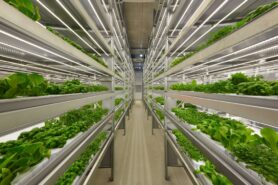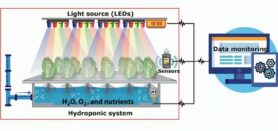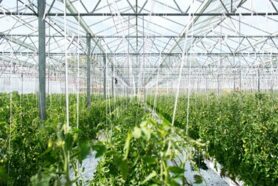What’s on your plate?
Farming without fields
Perhaps you have already eaten them without knowing it: vegetables that are not grown in the ground, but in a flat. So far there are three large “vertical farms” in the Netherlands. Not somewhere in the countryside, no, they are all in the big cities. A handy invention when you consider that in the future we will have to feed ten billion people. Current agricultural methods take up too much space for this. By controlling the growth factors – light, temperature and water- plants in the vertical farm can grow optimally all year round. Sounds good right? But, what will be the role of the vertical farm in the future?
How it works
In vertical farming, crops are grown in layers on top of each other, instead of side by side. All growth factors are carefully controlled in such a plant flat. This allows the plants to grow optimally all year round, even in winter. According to Lisanne Meulendijks, vertical farming specialist at the Delphy improvement center for greenhouse horticulture in Bleiswijk, the use of artificial intelligence is what makes vertical farming so interesting for young scientists. “As a result, food is suddenly linked to science”. Controlling with artificial intelligence has many advantages.

This is what it looks like: a vertical farm in Finland.
One of the advantages of vertical farming is the reduction of water use. Current agricultural methods require a lot of water, while this is becoming increasingly scarce due to climate change. In the vertical farm, the amount the plant receives is accurately determined. This is possible because the plants in the vertical farm usually do not grow in soil. As a result, water does not disappear into the soil. There are two commonly used methods to provide the plant with the right nutrients.
The first method is called hydroponics. Plants get all the necessary nutrients from a solution that is mixed with the water. The plants are watered accurately down to the drop. In this way, only three percent of the amount of water that would be needed in horizontal agriculture is used. The second method is called aeroponics. Here the plants get all the necessary nutrients from a richly filled aerosol, a kind of mist droplets that are sprayed over the plants. Which method a company ultimately uses does not really matter, according to Meulendijks. Ultimately, it is about a plant getting its nutrients as efficiently as possible.

A hydroponics system
To give light to the crops, the vertical farmers do not use daylight, but LED lamps. They can adjust the lamps in different ways to promote growth. The most important way is the exact light spectrum that the LED lamps emit. The sun radiates different types of light that a plant does not need. For example, plants do not absorb green light, they reflect that. That green light is therefore not used in the vertical farm. For example, by adding more red or blue light, plants can grow taller, get more roots or produce larger flowers.
Crops must meet a few conditions to be grown in a vertical farm. For example, according to Meulenbroeks, they should not be too long, because the shorter the crop, the more layers you can grow in the vertical farm with the same energy. The plant must also have a reasonably short growth cycle, so that it can be harvested often. Finally, the plant must consist of a relatively large amount of water and contain little ‘dry’ matter. The dry matter grows through photosynthesis, which requires light. If more light is needed, the LED lamps must therefore be on longer or more intensively. That takes a lot of energy. So the more water the plant contains, the less energy is needed.
The competitor
In vertical farming, the plants grow in layers one above the other, so a vertical farm needs ten to twenty times less land than in horizontal agriculture. Due to this space saving, this flat can be placed anywhere. For example, vacant offices in cities can be put to good use. That way, the vegetables are local and fresh. Using optimal growth factors, as mentioned earlier, also ensures that flat vegetables taste better than normally grown vegetables. According to Meulendijks, flat vegetables are even healthier! Finally, no pesticides need to be used. In the vertical farm, work is done very hygienically and it is monitored whether there are no insects inside. When there are insects inside, the vertical farmers use biological control agents, ladybugs or wasps, to combat them.
That all sounds great, but the Netherlands has a problem: the greenhouse. According to Meulendijks, greenhouse cultivation here is so well developed that it is difficult for the vertical farm to get in between. The disadvantages of vertical farming then outweigh the advantages. For example, greenhouses do not use artificial light, which makes them a lot more efficient when it comes to energy use. Although greenhouses cannot produce all year round, they are all in all cheaper. At least in the countryside. When you are going to look at a large city such as New York, where there is little light, it is of course super handy if there is a vertical farm next to the supermarket.

The competitor of the vertical farm: the greenhouse. As you can see, the plants in the greenhouse get normal sunlight.
The future
Meulendijks is not quite sure what vertical farming will look like in a few decades’ time. “Vertical farming is actually still so new that there are not many profitable farms in the world yet, but that does not mean that there is no potential in it. Fortunately, many large companies are investing, they certainly see a future in it. As a result, the vertical farms can continue to develop in the coming period. ”
All in all, Meulendijks thinks that vertical farming will become an indispensable addition to the agricultural methods we are already familiar with. “It will never replace arable farming and greenhouse cultivation, but it is a wonderful way to produce local and fresh food and to make people aware of where the food actually comes from.” Whether you have already eaten from a flat yourself? Chances are, because enough is sold in the supermarket.
References
AVROTROS (Regisseur). (2019). Met de lift om je kruiden te oogsten #dewereldvanmorgen [Film]. Opgehaald van https://www.youtube.com/watch?v=oyz0q3IXng4
Meulendijks, L. (2021, 3-10). Vertical farming. (A. Leerink, Interviewer)
Pierik, R., & Ballaré, C. (2021). Control of Plant Growth and Defense by Photoreceptors: From Mechanisms to Opportunities in Agriculture. Molecular Plant, 14(1), 61-76. doi:https://doi.org/10.1016/j.molp.2020.11.021
Schipper, R. (2021). Does Vertical Farming Use Chemicals. Indoor farming, opgehaald van https://planetrenewed.com/does-vertical-farming-use-chemicals/
Sharathkumar, M., Heuvelink, E., & Marcelis, L. (2020). Vertical Farming: Moving from Genetic to Environmental Modification. Trends in Plant Science, 25(8), 724-727. doi:https://doi.org/10.1016/j.tplants.2020.05.012
Tavan, M., Wee, B., Brodie, G., Fuentes, S., Pang, A., & Gupta, D. (2021). Optimizing Sensor-Based Irrigation Management in a Soilless Vertical Farm for Growing Microgreens. Sustain. Food Syst. doi:https://doi.org/10.3389/fsufs.2020.622720
Wageningen University & Research. (2021). Opgehaald van Verticale landbouw: https://www.wur.nl/nl/Dossiers/dossier/Verticale-landbouw.htm

